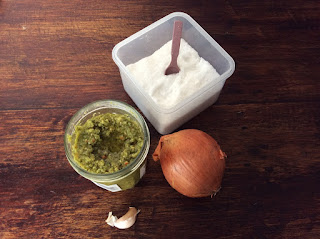In fact the title of this post is a bit misleading; when I told my Mauritian friends what I was planning to make, they'd never heard of it, let alone cooked it themselves.
In previous posts I've talked about my liking for local vegetables, especially pipangaille. In case you've forgotten or haven't been reading that long, it's this one:
Papy Pierre taught me how to prepare this with tomato, garlic, ginger and thyme, but I've heard also of a "chatini peau de pipangaille"; a kind of chutney that you make with the skin, which I normally remove and throw away. I was intrigued and decided to try it out using a recipe I found online.
The recipe says to use only the green part of the skin so I "pre-peeled" them to get rid of the old looking, brown parts. Let's face it, they're not very appetising, are they?
While the lovely, bright green peelings were boiling merrily in unsalted water for 30 minutes, I prepared the rest of the ingredients; onion, garlic, salt, and chili.
Mauritians eat a lot of chili but fortunately, it's mainly served on the side so I can avoid it. We didn't have any fresh chilies at home and the shops were closed because it's Sunday, so I used a very tiny spoonful of Volcano Chili, made by my Mother-in-Law. Even she overestimated its strength and left some on the side of her plate the last time she was here! It's basically just a lot of these, crushed with oil and salt:
The onion had to be finely chopped which was easy enough, and then, because I didn't read the recipe correctly, I crushed the garlic as well (you add it to the blender later so all you really have to do is peel it). In the interest of being like a true Mauritian, I didn't use my handy Ikea garlic press, opting instead for our pestle and mortar bought from a market stall, local style. Go me.
When the time was up, I poured away the water and put the pipangaille peelings in my blender along with the chili and garlic to produce a paste. It kept its nice, deep colour which I was very pleased about.
The final stage was to soften the chopped onion in a small amout of oil, before adding the pipangaille paste and some salt, and cooking on a low heat for about ten minutes. The result looked like this:
It looks nice, it tastes pretty good, and it got the Merv seal of approval. The problem is that we've never eaten it before and don't know what it's actually supposed to taste like! In the absence of any evidence to the contrary, I'm calling it a success.








No comments:
Post a Comment